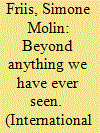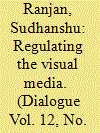| Srl | Item |
| 1 |
ID:
140267


|
|
|
|
|
| Summary/Abstract |
This article examines the role of the Islamic State of Iraq and Syria's (ISIS's) beheading videos in the United Kingdom and the United States. These videos are highly illustrative demonstrations of the importance of visual imagery and visual media in contemporary warfare. By functioning as evidence in a political discourse constituting ISIS as an imminent, exceptional threat to the West, the videos have played an important role in the re-framing of the conflict in Iraq and Syria from a humanitarian crisis requiring a humanitarian response to a national security issue requiring a military response and intensified counterterrorism efforts. However, this article seeks to problematize the role and status of ISIS's beheadings in American and British security discourses by highlighting the depoliticizing aspects of reducing a complicated conflict to a fragmented visual icon. The article concludes by emphasizing the need for further attention to how the visibility of war, and the constitution of boundaries between which acts of violence are rendered visible and which are not, shape the political terrain in which decisions about war and peace are produced and legitimized.
|
|
|
|
|
|
|
|
|
|
|
|
|
|
|
|
| 2 |
ID:
100888


|
|
|
| 3 |
ID:
108612


|
|
|
|
|
| Publication |
2011.
|
| Summary/Abstract |
Many sub-Saharan African societies have undergone significant political shifts in the last two decades. Changes in political representation and leadership have generated new forms of political mediation and communication. This article interrogates one of the most visible transformations in Kinshasa's political society: television news reports about urban misery, often resulting from a malfunctioning state, in which Kinshasa's inhabitants testify about their difficulties and press fellow citizens, as well as local and national leaders, to bring about change. Exposing suffering is a shame mobilisation strategy, and so becomes a political act. Through the discursive and visual aesthetics of the proximity account, citizens and political leaders are inserted into one political community. The main argument of this article is that the proximity account illustrates a new kind of political communication. In this article I analyse the socio-political contexts in which the proximity report emerged and became popular. I trace the materialisation of this new kind of interaction between political leaders and citizens to the transformation of the late Zaïrian 'state', to vernacular understandings of 'democracy', and to the influence of NGO activities and Pentecostal Christianity.
|
|
|
|
|
|
|
|
|
|
|
|
|
|
|
|